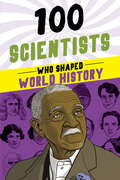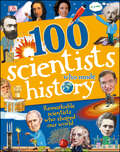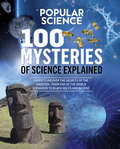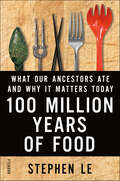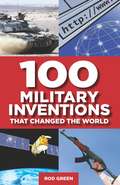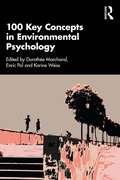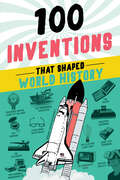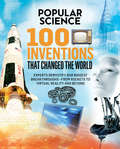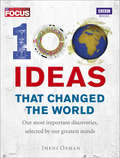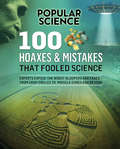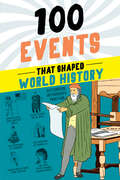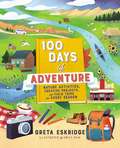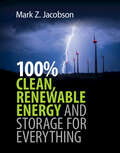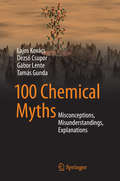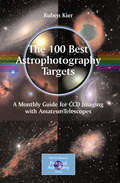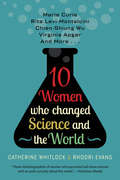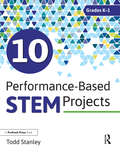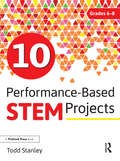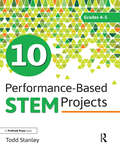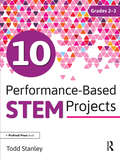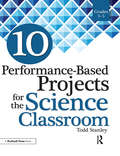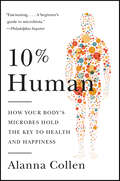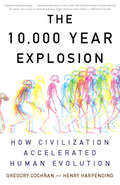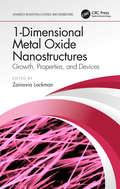- Table View
- List View
100 Scientists Who Shaped World History (100 Series)
by John Hudson TinerLearn all about the fascinating lives and tremendous impact of 100 extraordinary scientists from all over the world with this fact-filled biography collection for kidsEducational and engaging, 100 Scientists Who Shaped World History features:Simple, easy-to-read text that has been freshly updatedIllustrated portraits of each figureFascinating facts about famous and lesser-known scientistsA timeline, trivia questions, project ideas and more!From Pythagorus to Isaac Newton, Louis Pasteur to Marie Curie, Rosalind Franklin to Stephen Hawking and many more, readers will be introduced to the lives and accomplishments of the greatest scientists throughout history. Organized chronologically, 100 Scientists Who Shaped World History offers a look at the amazing discoveries and advancements made by these figures and shows how scientific contributions have helped guide humanity for thousands of years.
100 Scientists Who Made History (DK 100 Things That Made History)
by Andrea MillsFrom brainy biologists and clever chemists to magnificent mathematicians and phenomenal physicists. Discover 100 remarkable scientists who shaped our world.Containing a universe of knowledge, this amazing kids' educational book tells the story of the extraordinary people who revolutionized our understanding of the world. A stunning way for children to meet science's most important people.Read through information-packed mini-biographies of 100 brilliant scientists and innovators who have shaped our society and how we see the world around us. A perfect "everything you want to know in one place" about the history of science for children aged 8-12.Readers learn about discoveries that laid the groundwork for some of the most impressive innovations in history. Biologists, chemists, physicists, doctors, coders, and astronauts are all featured including Hippocrates, Da Vinci, Alan Turing, Stephen Hawking, Neil deGrasse Tyson, and more. An attractive and engaging kids book that may inspire the next Einstein or Curie! Made for those always curious children and those who need encouragement to aspire to greatness and see the marvels of science. Put children inside the minds of scientific heroes through clever speech bubbles alongside portraits with first-person fun facts about their lives. It's a cool way to personalize these incredible people and engage children while giving them a solid base in science. Did you know that Marie Curie's notebooks are still radioactive? They're too dangerous to touch and even glow! And Louis Pasteur, who furthered the development of vaccinations and more, liked to paint in his spare time? Who knew!Learn About The Minds Who Shaped The World!Dive into the world of theories and experiments, reactions, and equations, as we meet the figures who have helped us understand our universe and our place in it. Find out why Copernicus shook the world, what elements Marie Curie discovered, and how Franklin, Crick, and Watson unlocked the secrets of our DNA. It's divided into Pioneers, Biologists, Chemists, Physicists, and Innovators, whose innovations have changed the world and continue to change it now. Discover amazing facts about the world and the people behind some of humanity's most impressive advancements. Some of the amazing trailblazers you'll meet:- Alan Turing- Marie Curie- Barbara McClintock- Leonardo da Vinci- And so many more! This fabulous title is one of five children's books in the 100 In History series. Add 100 Women Who Made History, 100 People Who Made History, 100 Events That Made History, and 100 Inventions That Made History to your bookshelf and learn more about the significant people, events, and inventions that shaped the world we live in today.
100 Mysteries of Science Explained (Popular Science)
by The Editors of Popular ScienceAnswers on subjects from dark matter to disappearing bees, from the magazine that&’s been enlightening and entertaining Americans for nearly 150 years. What happened to the Neanderthals? When is the next Ice Age due? Why do we hiccup? From end-of-the-world scenarios to what goes on within our own brains and bodies, the experts at Popular Science magazine uncover the secrets of the universe and answer 100 of science&’s most mysterious questions. With sections on Physical Matter and Forces, Space, Human Body, Earth, Other Life-Forms, and Human Triumphs and Troubles, 100 Mysteries of Science Explained takes you into the fascinating world of black holes, time travel, DNA, earthquakes, and much more.
100 Million Years of Food: What Our Ancestors Ate and Why It Matters Today
by Stephen LeA fascinating tour through the evolution of the human diet and how we can improve our health by understanding our complicated history with food.There are few areas of modern life that are burdened by as much information and advice, often contradictory, as our diet and health: eat a lot of meat, eat no meat; whole grains are healthy, whole grains are a disaster; eat everything in moderation; eat only certain foods--and on and on. In 100 Million Years of Food, biological anthropologist Stephen Le explains how cuisines of different cultures are a result of centuries of evolution, finely tuned to our biology and surroundings.Today many cultures have strayed from their ancestral diets, relying instead on mass-produced food often made with chemicals that may be contributing to a rise in so-called Western diseases, such as cancer, heart disease, and obesity.
100 Military Inventions that Changed the World: That Changed The World
by Rod GreenNothing ensures the rapid development of new technology like the involvement of the military. <P><P>From the trebuchet and the cannon to the tank and the ballistic missile, military research programmes have produced the most devastating weapons imaginable, but military masterminds are responsible for a number of surprises along the way as well. Radar, walkie-talkies and the jet engine are more obvious examples of military inventions that are now in everyday use around the world, but there are plenty of items with which all of us come into contact on a daily basis that have been developed from military technology.<P>Rod Green describes how the microwave oven in your kitchen, the sat-nav in your car or the Internet that you use every day all owe their existence to the military as he takes us on a highly entertaining voyage of discovery through the world of military inventions ancient and modern.
100 Military Inventions that Changed the World: That Changed The World
by Philip RussellNothing ensures the rapid development of new technology like the involvement of the military. From the trebuchet and the cannon to the tank and the ballistic missile, military research programmes have produced the most devastating weapons imaginable, but military masterminds are responsible for a number of surprises along the way as well.Radar, walkie-talkies and the jet engine are more obvious examples of military inventions that are now in everyday use around the world, but there are plenty of items with which all of us come into contact on a daily basis that have been developed from military technology. Rod Green describes how the microwave oven in your kitchen, the sat-nav in your car or the Internet that you use every day all owe their existence to the military as he takes us on a highly entertaining voyage of discovery through the world of military inventions ancient and modern.
100 Key Concepts in Environmental Psychology
by Dorothée MarchandThis accessible book defines 100 key concepts, ideas and processes in Environmental Psychology to provide an introductory reference work that brings together research and theory in a bite-size format. With contributions from leading figures within Environmental Psychology, each concept is clearly defined and explained within the context of issues around the environment, sustainability, climate change, nature and architecture. This book considers the involvement of psychological, physiological and social processes to understand the mechanisms that explain and contribute to the evolution of behavior and attitudes that relate to our relationship with the environment. Concepts covered include biodiversity, eco-anxiety, place identity, sustainable behaviour, climate justice and environmental attitudes. By integrating ideas from different disciplinary orientations in the field of Environmental Psychology, this book allows for a better understanding of the processes related to the individual-environment relationship, as well as the applications that they allow for in various fields of intervention. This is essential reading for students and researchers in Environmental Psychology, Sustainability Studies, Architecture and Built Environment Studies and related fields.
100 Inventions That Shaped World History (100 Series)
by Bill YenneFascinating stories behind 100 of the most important inventions in history, for kids 8 and upThis fast-paced journey through the most vital developments and inventions of all time features:100 easy-to-read stories: Find out how each invention came to be!Illustrations: Each entry includes an illustrated image of the invention to help bring history to life!A timeline, trivia questions, project ideas and more: Boost your learning and test your knowledge with fun activities and resources!From the compass to the printing press, television to virtual reality, readers will learn about 100 of the most important inventions, advancements, and discoveries that have changed the course of human history. Organized chronologically, this fast-paced journey through the history of technology will help kids understand how their favorite modern conveniences came to be.
100 Inventions That Changed the World (Popular Science)
by The Editors of Popular ScienceFrom safety pins to steam engines to cell phones, the stories behind innovations that have transformed everyday lives. We take thousands of inventions for granted, using them daily and enjoying their benefits. But how much do we really know about their origins and development? This absorbing new book tells the stories behind the inventions that have changed the world, with details about: Convenience items, such as safety pins, toothbrushes, and bifocals Weapons of war, including explosives, gunpowder, and shrapnel shells Industrial advances, such as the steam engine and the power loom for weaving Transportation advances, including the airplane, the diesel engine, the automobile, and the air-inflated rubber tire Electronic marvels, including color television, the microprocessor, the personal computer, the compact disc, and the cell phone Medical advances, from antiseptic surgery to the electron microscope...and much more You&’ll also learn more about many inventors and pioneers of science and technology—including Eli Whitney, James Watt, Benjamin Franklin, Henry Bessemer, Thomas Edison, J.B. Dunlop, the Wright Brothers, Werner von Braun, Jonas Salk, J. Robert Oppenheimer, and others.
100 Ideas that Changed the World: Our Most Important Discoveries, Selected By Our Greatest Minds
by Jheni OsmanEvery once in a while, an idea comes along that makes the entire world sit up and take notice. From the earliest understandings of our place in the solar system, via Darwinism, DNA, neutrons and quarks, right up to the theories that are pushing the boundaries of our knowledge today, we are forever propelled forward by our most gifted scientific minds. In this fascinating book, former BBC Focus magazine editor Jheni Osman explores 100 of the most forward thinking, far-reaching and downright inspired ideas and inventions in history, each nominated by experts from all fields of science and engineering. With selections from established authorities such as Brian Cox, Patrick Moore, Richard Dawkins and Marcus du Sautoy, Osman covers topics as diverse as the Big Bang, vaccination, computing, radioactivity, human genomes, the wheel and many more. Each essay looks at the logic behind these great inventions, discoveries, theories and experiments, studying the circumstances that brought them into being and assessing the impact that they had on the world at large. An intriguing and thought-provoking collection, 100 Ideas that Changed the World offers us a glimpse into the minds behind history's greatest eureka moments.
100 Hoaxes & Mistakes That Fooled Science (Popular Science)
by The Editors of Popular ScienceEven experts get duped from time to time! The stories behind scientific fakes and mistakes, from crop circles to miracle cures and beyond. Science is an ongoing quest for knowledge filled with discoveries and experiments, trial and error. And occasionally, the errors can be whoppers—especially when hoaxers are involved. Some hoaxes are intended merely as well-intended humorous tricks, while others are serious frauds devised for personal gain of glory and riches. This book reveals the greatest science hoaxes and mistakes of all time. Discover the truth behind 100 of the most scandalous scientific errors and outright lies in this fascinating read brought to you by Popular Science—from the experiment that suggested time travel was possible, to the pursuit of alchemy, to rumors about red mercury and its mythical powers, it&’s an entertaining journey through the history of science.
100 Events That Shaped World History (100 Series)
by Bill YenneDiscover the fascinating stories behind the most important events of all time in this history book for kids 8 and up!From the founding of Rome to people walking on the moon, 100 Events That Shaped World History introduces kids to the greatest discoveries, most important battles, and most pivotal movements that changed the course of human history. This history book for kids features:100 easy-to-read stories of important moments in history: Find out how the modern world came to be!Illustrated images: Each page includes an illustration to help bring history to life!A timeline, trivia questions, project ideas, and more: Boost your learning and test your knowledge with fun activities and resources!Engaging and packed with facts, this book is the perfect classroom resource or history gift for curious kids!
100 Days of Adventure: Nature Activities, Creative Projects, and Field Trips for Every Season
by Greta EskridgeTurn off the screen and turn on the creativity as second-generation homeschooling mom Greta Eskridge shares 100 hands-on learning activities for kids that will connect and enrich your family through adventures, small and big.Have a meteor slumber party, attend a symphony concert, take a hike in the rain, preserve colorful fall leaves, and make nettle pesto as children explore a love of nature and venture into the great, wide, real world. From backyard bugs to farmer's market veggies, children will unplug from electronics; explore the world; and learn about nature, art, music, and themselves through STEAM projects and new experiences.100 Days of Adventure will spark curiosity in 6- to 10-year-olds withIndoor and outdoor seasonal activities, projects, experiments, crafts, recipes, and field tripsFree and low-cost activities, with options for different kinds of groups and locationsStep-by-step directions, nature journal prompts, tips, and checklistsBeautiful photos and helpful illustrationsChildren can bond with parents and siblings, learn new skills with individual investigations, or explore with friends in an educational or homeschool group with this full-color activity book. Also included is a note to parents with encouraging start-here guidance on growing a family culture of curiosity and adventure.Whether your family is looking for fun activities for school breaks at home, road trip vacations, or everyday ways to learn together, this collection of interactive educational activities will help your kids get creative, get into nature, and get closer to each other.Don't miss Greta's essential guide for parents on building a connected and loving family through exploration, Adventuring Together: How to Create Connections and Make Lasting Memories with Your Kids.
100% Clean, Renewable Energy and Storage for Everything
by Mark Z JacobsonNumerous laws – including the Green New Deal – have been proposed or passed in cities, states, and countries to transition from fossil fuels to 100% clean, renewable energy in order to address climate change, air pollution, and energy insecurity. This textbook lays out the science, technology, economics, policy, and social aspects of such transitions. It discusses the renewable electricity and heat generating technologies needed; the electricity, heat, cold, and hydrogen storage technologies required; how to keep the electric power grid stable; and how to address non-energy sources of emissions. It discusses the history of the 100% Movement, which evolved from a collaboration among scientists, cultural leaders, business people, and community leaders. Finally, it discusses current progress in transitioning to 100% renewables, and the new policies needed to complete the transition. Online course supplements include lecture slides, answers to the end-of-chapter student exercises, and a list of extra resources.
100 Chemical Myths: Misconceptions, Misunderstandings, Explanations
by Gábor Lente Lajos Kovács Dezső Csupor Tamás Gunda100 Chemical Myths deals with popular yet largely untrue misconceptions and misunderstandings related to chemistry. It contains lucid and concise explanations cut through fallacies and urban legends that are universally relevant to a global audience. A wide range of chemical myths are explored in these areas; food, medicines, catastrophes, chemicals, and environmental problems. Connections to popular culture, literature, movies, and cultural history hold the reader's interest whilst key concepts are beautifully annotated with illustrations to facilitate the understanding of unfamiliar material. Chemical Myths Demystified is pitched to individuals without a formal chemistry background to fledgling undergraduate chemists to seasoned researchers and beyond.
The 100 Best Astrophotography Targets
by Ruben KierAny amateur astronomer who is interested in astrophotography, particularly if just getting started, needs to know what objects are best for imaging in each month of the year. These are not necessarily the same objects that are the most spectacular or intriguing visually. The camera reveals different things and has different requirements. What objects in the sky tonight are large enough, bright enough, and high enough to be photographed? This book reveals, for each month of the year, the choicest celestial treasures within the reach of a commercial CCD camera. Helpful hints and advice on framing, exposures, and filters are included. Each deep sky object is explained in beautiful detail, so that observers will gain a richer understanding of these astronomical objects. This is not a book that dwells on the technology of CCD, Webcam, wet, or other types of astrophotography. Neither is it a book about in-depth computer processing of the images (although this topic is included). Detailed discussions of these topics can be found in other publications. This book focuses on what northern latitude objects to image at any given time of the year to get the most spectacular results.
10 Women Who Changed Science and the World (Trailblazers, Pioneers, and Revolutionaries)
by Rhodri Evans Catherine WhitlockSpanning the nineteenth and twentieth centuries, this fascinating history explores the lives and achievements of great women in science across the globe. Ten Women Who Changed Science and the World tells the stories of trailblazing women who made a historic impact on physics, biology, chemistry, astronomy, and medicine. Included in this volume are famous figures, such as two-time Nobel Prize winner Marie Curie, as well as individuals whose names will be new to many, though their breakthroughs were no less remarkable. These women overcame significant obstacles, discrimination, and personal tragedies in their pursuit of scientific advancement. They persevered in their research, whether creating life-saving drugs or expanding our knowledge of the cosmos. By daring to ask ‘How?’ and ‘Why?’, each of these women made a positive impact on the world we live in today. In this book, you will learn about: AstronomyHenrietta Leavitt (United States, 1868–1921) discovered the period-luminosity relationship for Cepheid variable stars, which enabled us to measure the size of our galaxy and the universe. PhysicsLise Meitner (Austria, 1878–1968) fled Nazi Germany in 1938, taking with her the experimental results which showed that she and Otto Hahn had split the nucleus and discovered nuclear fission. Chien-Shiung Wu (United States, 1912–1997) demonstrated that the widely accepted ‘law of parity’, which stated that left-spinning and right-spinning subatomic particles would behave identically, was wrong. ChemistryMarie Curie (France, 1867–1934) became the only person in history to have won Nobel prizes in two different fields of science. Dorothy Crowfoot Hodgkin (United Kingdom, 1910–1994) won the Nobel Prize for Chemistry in 1964 and pioneered the X-ray study of large molecules of biochemical importance. MedicineVirginia Apgar (United States, 1909–1974) invented the Apgar score, used to quickly assess the health of newborn babies. Gertrude Elion (United States, 1918–1999) won the Nobel Prize for Physiology or Medicine in 1988 for her advances in drug development. BiologyRita Levi-Montalcini (Italy, 1909–2012) won the Nobel Prize for Physiology or Medicine in 1986 for her co-discovery in 1954 of Nerve Growth Factor (NGF). Elsie Widdowson (United Kingdom, 1906–2000) pioneered the science of nutrition and helped devise the World War II food-rationing program. Rachel Carson (United States, 1907–1964) forged the environmental movement, most famously with her influential book Silent Spring.
10 Performance-Based STEM Projects for Grades K-1
by Todd Stanley10 Performance-Based STEM Projects for Grades K-1 provides 10 ready-made projects designed to help students achieve higher levels of thinking and develop 21st-century skills while learning about science, technology, engineering, and math. Projects are aligned to national standards and feature crosscurricular connections, allowing students to explore and be creative as well as gain an enduring understanding. Each project is linked to national STEM education goals and represents one of a variety of performance assessments, including oral presentations, research papers, and exhibitions. Included for each project are a suggested calendar to allow teachers to easily plan a schedule, mini-lessons that allow students to build capacity and gain an understanding of what they are doing, as well as multiple rubrics that can be used to objectively assess the performance of students. The lessons are laid out in an easy-to-follow format that will allow teachers to implement the projects immediately. Grades K-1
10 Performance-Based STEM Projects for Grades 6-8
by Todd Stanley10 Performance-Based STEM Projects for Grades 6-8 provides 10 ready-made projects designed to help students achieve higher levels of thinking and develop 21st-century skills while learning about science, technology, engineering, and math. Projects are aligned to national standards and feature crosscurricular connections, allowing students to explore and be creative as well as gain an enduring understanding. Each project is linked to national STEM education goals and represents one of a variety of performance assessments, including oral presentations, research papers, and exhibitions. Included for each project are a suggested calendar to allow teachers to easily plan a schedule, mini-lessons that allow students to build capacity and gain an understanding of what they are doing, as well as multiple rubrics that can be used to objectively assess the performance of students. The lessons are laid out in an easy-to-follow format that will allow teachers to implement the projects immediately. Grades 6-8
10 Performance-Based STEM Projects for Grades 4-5
by Todd Stanley10 Performance-Based STEM Projects for Grades 4-5 provides 10 ready-made projects designed to help students achieve higher levels of thinking and develop 21st-century skills while learning about science, technology, engineering, and math. Projects are aligned to national standards and feature crosscurricular connections, allowing students to explore and be creative as well as gain an enduring understanding. Each project is linked to national STEM education goals and represents one of a variety of performance assessments, including oral presentations, research papers, and exhibitions. Included for each project are a suggested calendar to allow teachers to easily plan a schedule, mini-lessons that allow students to build capacity and gain an understanding of what they are doing, as well as multiple rubrics that can be used to objectively assess the performance of students. The lessons are laid out in an easy-to-follow format that will allow teachers to implement the projects immediately. Grades 4-5
10 Performance-Based STEM Projects for Grades 2-3
by Todd Stanley10 Performance-Based STEM Projects for Grades 2-3 provides 10 ready-made projects designed to help students achieve higher levels of thinking and develop 21st-century skills while learning about science, technology, engineering, and math. Projects are aligned to national standards and feature crosscurricular connections, allowing students to explore and be creative as well as gain an enduring understanding. Each project is linked to national STEM education goals and represents one of a variety of performance assessments, including oral presentations, research papers, and exhibitions. Included for each project are a suggested calendar to allow teachers to easily plan a schedule, mini-lessons that allow students to build capacity and gain an understanding of what they are doing, as well as multiple rubrics that can be used to objectively assess the performance of students. The lessons are laid out in an easy-to-follow format that will allow teachers to implement the projects immediately. Grades 2-3
10 Performance-Based Projects for the Science Classroom: Grades 3-5
by Todd StanleyEach book in the 10 Performance-Based Projects series provides 10 ready-made projects designed to help students achieve higher levels of thinking and develop 21st-century skills. Projects are aligned to the Next Generation Science Standards, allowing students to explore and be creative as well as gain enduring understanding. Each project represents a type of performance assessment, including portfolios, oral presentations, research papers, and exhibitions. Included for each project is a suggested calendar to allow teacher scheduling, mini-lessons that allow students to build capacity and gain understanding, as well as multiple rubrics to objectively assess student performance. The lessons are presented in an easy-to-follow format, enabling teachers to implement projects immediately. Grades 3-5
10% Human: How Your Body's Microbes Hold the Key to Health and Happiness
by Alanna CollenNow in paperback, evolutionary biologist and science writer Alanna Collen’s stunning alarm call concerning the widely-ignored role our gut microbes play in our health and well-being.“Fascinating…. Everything you wanted to know about microbes but were afraid to ask.”— Kirkus Reviews (starred review)You are just 10% human. For every one of the cells that make up the vessel that you call your body, there are nine impostor cells hitching a ride. You are not just flesh and blood, muscle and bone, brain and skin, but also bacteria and fungi. Over your lifetime, you will carry the equivalent weight of five African elephants in microbes. You are not an individual but a colony.Until recently, we had thought our microbes hardly mattered, but science is revealing a different story, one in which microbes run our bodies and becoming a healthy human is impossible without them.In this riveting, shocking, and beautifully written book, biologist Alanna Collen draws on the latest scientific research to show how our personal colony of microbes influences our weight, our immune system, our mental health, and even our choice of partner. She argues that so many of our modern diseases—obesity, autism, mental illness, digestive disorders, allergies, autoimmunity afflictions, and even cancer—have their root in our failure to cherish our most fundamental and enduring relationship: that with our personal colony of microbes.The good news is that unlike our human cells, we can change our microbes for the better. Collen’s book is a revelatory and indispensable guide. Life—and your body—will never seem the same again.
The 10,000 Year Explosion: How Civilization Accelerated Human Evolution
by Gregory Cochran Henry HarpendingTwo leading researchers make the controversial argument that our species is still measurably evolving in important ways?in fact, faster than ever before.
1-Dimensional Metal Oxide Nanostructures: Growth, Properties, and Devices (Advances in Materials Science and Engineering)
by Zainovia Lockman1-D metal oxide nanostructures, especially those with semiconducting properties, have attracted much attention in recent years due to their potential and emerging applications, specifically in environment purification and energy devices. For these applications, there have been many efforts to grow 1-D nanostructures in the form of nanotubes, nanorods, and nanowires using processes that conserve energy, are cost effective, and can be scaled up for large-scale production. 1-Dimensional Metal Oxide Nanostructures gathers under one title the most recent development of oxide nanomaterials, especially those fabricated via oxidation process in the nanoscale field. Thermal and anodic oxidation processes are reviewed with an aim to offer an in-depth understanding of mechanisms of 1-D nanostructure formation, their characteristics, and limitations. Other more common methods are also discussed, including sol-gel, hydrothermal, and other templated methods. Important applications of 1-D nanostructures are then presented, focusing on oxides like zinc oxide, titanium oxide, zirconium oxide, copper oxide, and iron oxide. A chapter on carbon nanotubes hybrid with these oxides is also included as well as one on silicon oxide nanowires formation by local anodic oxidation process. Aimed at researchers, academics, and engineers working across the fields of nanotechnology, materials science, chemistry, physics, semiconductors, and environmental and biomedical engineering, this essential reference enables readers to grasp the main concepts of nanomaterials in 1-D: formation technique, characteristics, and uses. It also encourages practical innovations in nanotechnology, especially in curbing pressing global issues related to energy, environment, and security.
